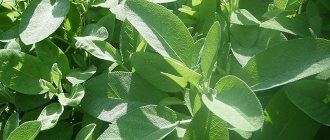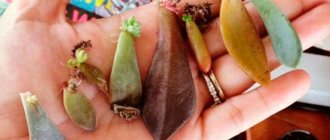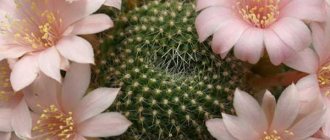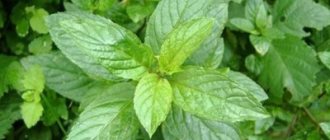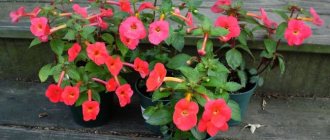Jatropha (Jatropha) is directly related to the spurge family (Euphorbiaceae). This genus is represented by shrubs, trees, and herbaceous plants that have milky sap. In nature, it can be found in the tropical regions of Africa and America. The name of such a plant is derived from the Greek words Jatrys - “doctor” and tropha - “food”. Jatropha is a rather unusual plant. It has a bottle-shaped stem. It is naked throughout the winter period, but at the beginning of spring it has umbrella-shaped flower stalks consisting of small red flowers. After some time, leaves with long petioles begin to grow. Jatropha is very difficult to find in flower shops.
If you wish, you can try to find it from flower growers who collect succulents, as well as in botanical gardens. The large jatropha species is very expensive, but caring for such a plant is very simple.
This plant can add zest to any interior just like a bonsai. It blooms regularly, and bright umbrellas on long legs look quite impressive. Often, jatropha begins to bloom first, and then broad-lobed leaves with long petioles, 10–20 centimeters long, grow.
Description
Attracted by the trunk - a bottle, it grows up to 50 cm. The plant is deciduous, i.e. in winter the stem is bare, and with the onset of spring, flower stalks appear in the form of umbrellas with small red flowers.
Jatropha flowers are bisexual and can be orange, deep pink or red. Fruits require cross pollination. Oval fruits are about 25 cm, 3-sided in shape, each with 2-3 oval seeds.
Only in summer do finger-shaped leaves of various green colors grow.
Important! “Milk” - the poisonous juice of jatropha, like all milkweeds, can burn.
3.Varieties:
3.1.Gouty jatropha - Jatropha podagrica
A beautiful succulent plant, with age it forms an erect trunk with a thickening - a caudex at the base, resembling a bottle and covered with grayish or light brown bark. At the top of the trunk there is a lush crown formed from large, dark green, palmately dissected leaves. The edges of the leaf blades are corrugated, young leaves are often very dark - almost black, with highlighted light veins. During the flowering period, the plant shoots out from the top of the trunk a low, strong peduncle, at the top of which there is an inflorescence - an umbrella with yellow, orange or pink flowers.
↑ Up,
3.2. Jatropha integerrima, entire - Jatropha integerrima
In its natural environment, this species reaches a height of 4.5 m and is a dense, multi-stemmed shrub or small tree. As the name suggests, the plant has simple, oblong-oval, “whole-edged” emerald-green leaves with branched veins and long petioles. The leaf blades may be slightly bent along the central vein. The flowers are bright pink, with 5 oblong petals, collected in inflorescences - small umbrellas on the tops of the shoots.
↑ Up,
3.3. Jatropha curcas
This subspecies can grow as a multi-stemmed shrub or a strong tree with large, palmately dissected green leaves, forming a luxurious crown. The leaf blades are covered with a large network of veins and have slightly corrugated edges. The flowers are small, greenish, inconspicuous, flowering is not of particular interest. After flowering, the plant produces drooping, elongated green fruits, which turn yellow when ripe and then dry out and turn brown. These fruits resemble a lemon in shape.
↑ Up,
3.4. Dissected jatropha - Jatropha multifida
A very delicate, airy plant with beautiful compound leaves, consisting of several long, drooping, lanceolate leaf plates (15 - 30 cm in length) and long petioles. In nature, this subspecies reaches a height of 3 m. When damaged, the stems secrete poisonous milky juice. The flowers are small, bright red, collected in umbrellas on the tops of strong shoots.
↑ Up,
Flower care at home
Light
Jatropha loves light, but not direct sun. East and west windows are ideal. The transition to bright light and vice versa must be acclimated to the plant gradually. Also the transition to winter.
Temperature
In warm weather, jatropha prefers +18-25 degrees; in winter it should be lowered to 10-15 degrees. The plant is afraid of drafts.
Watering
Moderate watering in spring and summer, the soil should dry out. Excess water can cause the plant to rot.
The jatropha stores moisture in its trunk; it had to survive a long drought in nature. Therefore, stop watering in winter. Only start watering in the spring, when it starts to bloom.
It does not need a lot of humidity; occasionally you can wipe the leaves with a damp sponge to remove dust.
Growing problems:
- The leaves turn pale and wither if the plant is watered with very cold water. It is recommended to warm the water slightly before watering;
- Growth slows down most often due to excessive fertilization. Don't fertilize next month;
- The foliage turns yellow and dies, most likely due to the plant being attacked by spider mites. Start spraying the jatropha with warm water every day 3 times a day;
- Flowers die and become deformed when attacked by thrips. Apply insecticides.
Views: 876
Transplantation and soil for jatropha
It is recommended to replant jatropha every 3 years, preferably in spring (summer). The pot is not needed to be deep, but it must be stable (wide), because the “bottle” has weight. It should be replanted with a clod of earth, preserving the soil around the roots.
Drainage is required: expanded clay, small stones, maybe clay shards for 1/3 of the pot. After replanting, you need to mulch the soil surface so that moisture does not evaporate, the soil is not washed out or weathered. The same materials can be used.
The soil for the plant needs to be light and loose. You can buy ready-made substrate for succulents or cacti. Mixture for jatropha: leaf soil, sand, peat and turf (2x1x1x1).
Reproduction
Jatropha can be propagated at home by cuttings or seeds. For propagation by the vegetative method, by means of cuttings, the upper cuttings measuring 10 cm are cut from the trunk of the mother plant, the sections are dried until the juice ceases to be released. They are then treated with a root growth stimulator and placed in a container with soil for cacti and succulents.
For better rooting, greenhouse conditions are required. Warm soil and the greenhouse effect. The cuttings take root within a month, after which they are transplanted into separate pots.
Propagation by seeds is difficult due to the fact that only fresh seeds can sprout. 2-3 months after they ripen, they lose the ability to germinate.
Fresh seeds should be placed superficially, without going deep, into a container with moist jatropha soil. Then, covering them with film, maintain the greenhouse temperature at around 25°C all the time.
In a couple of weeks, the first shoots with leaves will appear. Then they can be planted in individual pots. In a couple of months a small crown will appear, and in a year the young seedling will bloom.
Organization of watering
When organizing watering, it should be remembered that excess moisture can cause the development of rot, reduce the plant’s immunity, and lead to the development of infectious diseases. To maintain normal soil moisture in a flower pot, a number of measures should be taken:
- When replanting, be sure to lay a high-quality drainage layer at the bottom of the container, which will promote uniform distribution of moisture in the pot.
- The soil for planting a flower must be nutritious, loose, and have sufficient porosity.
There is also a rule for watering a flower:
- In the autumn, the frequency of watering is reduced, and after all the leaves fall off, soil moisture is completely stopped. The structural and physiological features of succulents allow the plant to expend moisture accumulated during the spring-summer period.
- Watering is carried out only with settled warm water, which will not lead to hypothermia of the roots.
- The soil should be moistened only after the top layer of soil has dried.
Any appearance of signs of hypothermia or disease (withering and falling of leaves, the appearance of a gray coating on the leaves, rot, an unpleasant odor) is the first sign of excessive watering.

